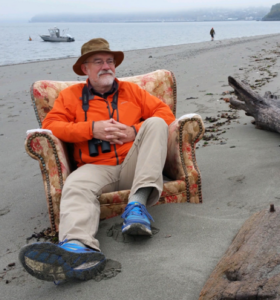
LECTURE – Diamond: A Multifaceted Gem
QGS hosted former QGS advisor and emeritus professor, Jeff Tepper on February 15, 2025.
Jeff’s lecture described that diamonds have been revered as precious stones for over 2000 years, yet they are composed simply of carbon, one of the most common elements on Earth. He explained their rarity arises from the fact that they form at extreme pressures deep in the  Earth’s mantle and then are brought rapidly to the surface in CO2-rich explosive eruptions. No such eruptions have occurred in human history, but we know they occur only in the interiors of continents, where they produce narrow vertical ‘kimberlite pipes’ that are mined in Africa, Russia, and, more recently, Canada. Tiny diamonds with a completely different origin have been found in meteorites, and some of these appear to predate the formation of our solar system. Nowadays, diamonds can also be grown artificially, and these synthetic crystals are widely used in industry and, increasingly, in jewelry. For geologists, diamonds are invaluable tools for understanding the Earth’s interior.
Earth’s mantle and then are brought rapidly to the surface in CO2-rich explosive eruptions. No such eruptions have occurred in human history, but we know they occur only in the interiors of continents, where they produce narrow vertical ‘kimberlite pipes’ that are mined in Africa, Russia, and, more recently, Canada. Tiny diamonds with a completely different origin have been found in meteorites, and some of these appear to predate the formation of our solar system. Nowadays, diamonds can also be grown artificially, and these synthetic crystals are widely used in industry and, increasingly, in jewelry. For geologists, diamonds are invaluable tools for understanding the Earth’s interior.  They are used to make tiny “anvils” that allow us to conduct high-pressure laboratory experiments that replicate conditions deep inside the Earth, and they commonly contain minute inclusions of other minerals that are our only actual samples of mantle materials from depths as great as ~400 km (250 miles). Jeff provided how and where diamonds form, offered a brief summary of how we search for them, described their history as gemstones, and detailed what they tell us about our planet’s deep interior.
They are used to make tiny “anvils” that allow us to conduct high-pressure laboratory experiments that replicate conditions deep inside the Earth, and they commonly contain minute inclusions of other minerals that are our only actual samples of mantle materials from depths as great as ~400 km (250 miles). Jeff provided how and where diamonds form, offered a brief summary of how we search for them, described their history as gemstones, and detailed what they tell us about our planet’s deep interior.
This in-person lecture was on Saturday, February 15, 2025 at the Port Townsend First Baptist Church.
ABOUT THE SPEAKER
Jeff Tepper was on faculty of the Geology Department at the University of Puget Sound from 2001-2021 and has been emeritus since then. He earned his PhD from UW, where he studied the origins of granite in the North Cascades. At UPS he taught classes in mineralogy, petrology, geochemistry, GIS, and geomythology. Most of his research projects focus on the magmatic and tectonic history of the Pacific Northwest (including Tamanowas Rock) and geochemistry of water and sediment from Tacoma-area lakes. Visit Jeff’s website for more information: https://www.jeffreytepper.com/.





 THE SPEAKER:
THE SPEAKER:
 Ralph Haugerud is an exceptional geologist. Many describe him as a structural geologist and geologic mapper interested in the evolution of the Pacific Northwest, and many know about his popularity from being featured on Nick Zentner’s programs.
Ralph Haugerud is an exceptional geologist. Many describe him as a structural geologist and geologic mapper interested in the evolution of the Pacific Northwest, and many know about his popularity from being featured on Nick Zentner’s programs.